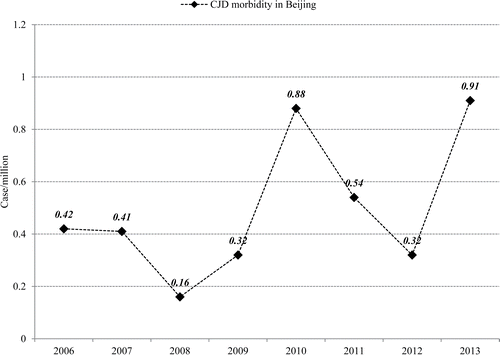Abstract
ABSTRACT. Since 2006, China has conducted the surveillance program for Creutzfeldt-Jakob disease (CJD) and other subtypes of prion diseases covering 12 provinces. In this study, the characteristics and special role of Beijing CJD surveillance network in the national CJD surveillance system were analyzed. Based on the registered permanent resident places, all reporting suspected CJD cases and diagnosed CJD cases via Beijing CJD surveillance network between 2006 and 2013 were grouped as the cases from Beijing and from outside of Beijing. Both numbers of the suspected and diagnosed CJD cases via Beijing CJD surveillance network constantly increased along with the years, totally 532 reporting cases and 192 diagnosed CJD cases were obtained in the past 8 y. About 75% of suspected and diagnosed CJD cases via Beijing CJD surveillance network came from other provinces, mainly from neighboring provinces. Altogether, 46 different hospitals in the Beijing region have reported suspected CJD cases to the CJD surveillance system during the period from 2006 to 2013. Five hospitals continually reported suspected CJD cases during those 8 y and 5 other hospitals had reported cases except for 1 to 2 y. Additionally, we found that the diagnosed CJD patients from Beijing region had less numbers of hospital transfer and shorter interval from the disease onset to the final diagnosis than those outside of Beijing. It indicates that as the most important component, Beijing CJD surveillance network functions more actively, which supplies the special medical services not only for Beijing residents but also for patients from all of China.
Keywords:
Abbreviations
| CJD | = | Creutzfeldt-Jakob disease |
| sCJD | = | sporadic CJD |
| gCJD | = | genetic CJD |
| iCJD | = | iatrogenic CJD |
| vCJDvariant | = | CJD |
| PrP | = | prion protein |
| TSEs | = | transmissible spongiform encephalopathies |
| EEG | = | Electroencephalograph |
| CSF | = | cerebrospinal fluid |
Background
Human TSEs can be also etiologically classified as the forms of sporadic, such as sporadic CJD (sCJD), genetic or familial, such as genetic CJD (gCJD), Gerstmann-Sträussler-Scheinker syndrome (GSS) and fatal familial insomnia (FFI), and acquired, such as iatrogenic CJD (iCJD) and variant CJD (vCJD).Citation1,2 The conversion of host prion protein (PrP), coded by the PRNP gene, from its cellular form PrPC to its pathogenic isoform PrPSc through a post-translational process is considered the etiology of these diseases.Citation3
Human transmissible spongiform encephalopathies (TSEs) can be diagnosed according to the clinical manifestations, clinical examinations and laboratory tests. Based on the diagnostic criteria for CJD issued by WHO, the clinical manifestations of sCJD contain progressive dementia and 4 other signs: myoclonus, visual or cerebellar disturbance, pyramidal or extrapyramidal disfunction and akinetic mutism.Citation4 Electroencephalograph (EEG) and (MRI), as well as 14-3-3 protein test in cerebrospinal fluid (CSF) re listed as the examination tools for CJD diagnosis.Citation5-7 Clinically, the above listed symptoms are not specific for CJD, which may present in many other neurological diseases. Positive results in EEG, MRI and CSF 14-3-3 can efficiently increase the accuracy of the diagnosis for CJD, but still not enough to exclude the possibility of misdiagnosis.Citation8,9 An absolutely definite diagnosis of any form of CJD usually requires either pathological or pathogenic examination of brain tissues.Citation10 As a rare disease, the incidence of CJD is speculated as 1 to 2 case per million per year worldwide.Citation11 Due to lacking of knowledge of CJD and relevant techniques for diagnosis, only a few cases have been described in Chinese scientific journals in the 90s last century. The CJD patients were recognized and diagnosed only in a few of university polyclinics in metropolis. In 2006, a national surveillance program for CJD was conducted in China, which was supported by Chinese Center for Disease Control and Prevention (China CDC).Citation12 Since then, more than 1600 suspected CJD cases have been reported to the CJD surveillance system and roughly 800 cases have been diagnosed as sCJD, gCJD or FFI. Meanwhile, successive training courses regarding prion and prion diseases, human and animal TSEs surveillance, CJD clinical and laboratory diagnosis were conducted, which definitely promoted the diffusion of CJD knowledge among the physician, especially in the cities conducting CJD surveillance.
As the politic and economic center of China, Beijing has the top-level medical resources in China. More than 50 top level lager hospitals (Degree A in Class 3) locate in Beijing region, which supplies medical services for the patients not only from Beijing but also outside Beijing. Such medical advantage makes Beijing CJD surveillance network functions more actively. To obtain the characteristics and special role of Beijing CJD surveillance network in the national CJD surveillance system, the data of the suspected and diagnosed CJD cases from Beijing were analyzed based on the geography distributions of the patients, the constitutions of reporting hospitals and consuming times from onset to medical service in this study.
Methods
Constitution of National CJD Surveillance System and Beijing Municipal CJD Network
China national CJD surveillance has started formally since 2006 under the leadership of China CDC. It consisted of 12 provincial CDCs and 15 hospitals, distributing in Beijing, Shanghai, Tianjin, Chongqing, Jilin, Shaanxi, Hubei, Guangdong, Guizhou, Anhui, Henan and Xinjiang. The surveillance program was approved by the Ethical Review Committee of China CDC. Beijing municipal CJD network started in 2002, with a sentinel hospital as the clinical reference unit, Beijing municipal CDC as the epidemiological investigator and information collector, and Department of prion disease in China CDC as the laboratory. In 2006, this network jointed into national CJD surveillance system which covered more hospitals having department of neurology in Beijing. Since 2009, Beijing municipal CJD network expanded to all hospitals in Beijing region. Based the surveillance documents, the clinical data and specimens of the suspected patients were collected by the clinician from hospitals, while the epidemiological data were collected by the staff of provincial CDCs. The collected data and sample were referred to the national reference laboratory for human prion disease, CCDC, for laboratory tests and final diagnosis.
Case Definition
The suspected CJD cases from CJD surveillance were diagnosed and subtyped based on the diagnostic criteria issued by China CDC, which was constituted based on the diagnostic criteria for CJD issued by WHO. Since 2010, high signal in caudate/putamen on MRI brain scan has been added into the criteria according to the renewed version issued by WHO.Citation13 The final diagnosis was made by an expert board including neurologists, neuropathologists, epidemiologists and laboratory staff.
Collections of Clinical and Epidemiological Data
The clinical and epidemiological data of the suspected patient were collected with the designed questionnaires. The clinical data included the general information, main clinical manifestations, the foremost symptom and clinical examinations (CT, MRI, EEG and routine CSF biochemistry). The epidemiological data included inhabitancy, family history, anamnesis (surgical or neurosurgical history, organ transplantation, blood donation and transfusion, use of extracts of pituitary or other blood products), and profession (especially medical staff, veterinary and butcher).
Results
The Suspected and Diagnosed CJD Cases from Beijing and Outside of Beijing since 2006
From 2006 to 2013, totally 1,355 suspected CJD cases were reported via China national CJD surveillance system, among them 455 were diagnosed as different subtypes of human prion diseases based on the diagnostic criteria, including sCJD, gCJD, FFI and GSS. No vCJD and definite iCJD were addressed. As most active component in China national CJD surveillance system, Beijing municipal CJD network had reported 532 suspected CJD cases, which accounting for 39.3% of whole suspected CJD cases in China. 172 cases were diagnosed as sCJD (172), and 20 cases as various genetic human prion diseases. The numbers of CJD and other prion diseases diagnosed from Beijing accounted for 42.2% of whole numbers in China.
The numbers of both suspected and diagnosed CJD cases from Beijing municipal CJD network increased stably in the period from 2006 to 2013, from 44 suspected and 14 diagnosed cases in 2006 to 146 suspected and 69 diagnosed cases in 2013 (). In order to see the origins of the patients, we divided the patients into 2 groups, the group from Beijing whose long-term residences were Beijing region and group outside of Beijing whose long-term residences were outside of Beijing. As shown in , generally larger portions of suspected and diagnosed CJD patients come from the places outside of Beijing, especially in the past 2 y. The ratios of the suspected cases between the groups outside of Beijing and from Beijing varied from 1.75 (in 2006) to 4.03 (in 2013), with the median of 3.07. Meanwhile, the ratios of the diagnosed cases between the groups of outside of Beijing and from Beijing varied from 1.09 (in 2010) to 7.0 (in 2013), with the median of 1.9. Those data indicate that more than 3/4 suspected cases and roughly 2/3 diagnosed cases from Beijing CJD surveillance network are the patients outside of Beijing region.
Figure 1. The reporting suspected CJD cases (A) and diagnosed CJD cases (B) via Beijing CJD surveillance network during 2006 and 2013. Based on their registered permanent resident place, the patients are grouped as from Beijing region and from outside of Beijing. The total and the individual cases numbers are indicated.
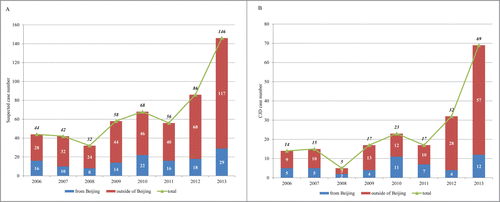
Based on the population numbers of permanent residents in Beijing issued by Beijing municipal government, the CJD incidences were calculated. The morbidity of CJD in Beijing region based on the diagnosed CJD cases via CJD surveillance system during 2006 and 2013 was shown in . Except the data of years 2010 (0.88) and 2013 (0.91) that were close to the expected value (1 case/million/year), the CJD incidences of the rest 6 y were significantly lower, which may highlight that there were CJD cases undiagnosed and/or misdiagnosed.
Geography Distribution of the Permanent Residence of the CJD Cases Diagnosed in Beijing
To see the geography origins of the suspected and diagnosed CJD cases outside of Beijing, the case numbers were further sub-calculated based on the provinces they permanently lived. In addition to 133 suspected cases from Beijing, the rest 399 cases came from other 29 difference provinces or administrative region, including 1 from Mongolia and 2 from Australia. The top 5 provinces were Hebei (91 cases), Shandong (59 cases), Inner Mongolia (43 cases), Shanxi (41 cases) and Henan (40 cases), which were the provinces in north China (). More suspected cases were also from 3 provinces in Northeast China, including Liaoning (35 cases), Heilongjiang (17 cases) and Jilin (14 cases). Contrarily, less numbers of the suspected cases came from southern part of China. Among the diagnosed CJD cases, 50 were from Beijing and 143 were from 26 difference provinces or administrative region, including 1 from Australia. The top 5 provinces were Hebei (31 cases), Shandong (23 cases), Inner Mongolia (13 cases), Henan (13 cases) and Shanxi (12 cases) (). It is obvious that the neighbor provinces contribute more numbers of CJD patients to Beijing.
Figure 3. Geography distributions of the reporting suspected CJD cases (A) and diagnosed CJD cases (B) via Beijing CJD surveillance network from 2006 to 2013. The case number(s) are indicated according to the province-level administrative. The abbreviations of the provinces were as follows: Heilongjiang (HLJ), Jilin (JL), Liaoning (LN), Beijing (BJ), Tianjin (TJ), Neimenggu (NMG), Hebei (HB), Henan (HN), Shandong (SD), Shanxi (SX), Hubei (HUB), Hunan (HUN), Anhui (AH), Jiangsu (JS), Shan'xi (SHX), Ningxia (NX), Gansu (GS), Qinghai (QH), Sichuan (SC), Chongqing (CQ), GUizhou (GZ), Xinjiang (XJ), Xizang (XZ), Yunnan (YN), Jiangxi (JX), Zhejiang (ZJ), Fujian (FJ), Guangxi (GX), Guangdong (GD), Hainan (HI), Taiwan (TW), Hongkong (HK), Macao (MC).
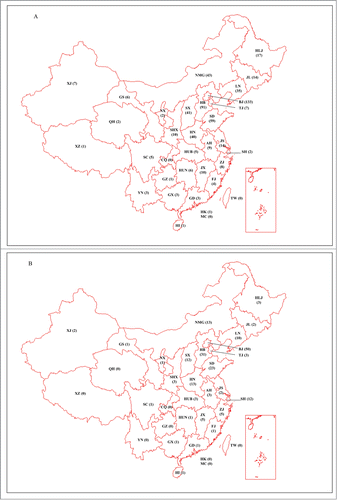
The Suspected and Diagnosed CJD Cases from the Hospitals in Beijing
The suspected and diagnosed CJD cases from Beijing CJD surveillance network were grouped according to the reporting hospitals. From 2006 to 2013, there were totally 46 different hospitals in Beijing region have reported suspected CJD cases to the CJD surveillance system in China CDC. Five hospitals continually reported suspected CJD cases during those 8 y and 5 other hospitals had reported cases except for 1 to 2 y The reporting hospitals started from 12 in 2006, climbed to 18 since 2010 and reached to 24 in 2013 (). The suspected case numbers from individual hospital varied from only one case to 191 cases. Twelve hospitals had more than 10 suspected cases, and among them, 5 had more than 20 cases (). Similarly, the numbers of hospitals having diagnosed CJD cases were 6 in 2006, became 11 in 2010 and reached to 17 in 2013 (). Totally 26 hospitals had diagnosed CJD cases and the case numbers varied from one to 61, among them, 4 hospitals had more than 20 diagnosed CJD cases (). The top 5 hospitals having more diagnosed CJD cases overlapped well with the top 5 ones having more reporting cases.
Figure 4. The hospital-based information of the reporting suspected CJD cases (A) and diagnosed CJD cases (B) via Beijing CJD surveillance network from 2006 to 2013. Left panels show the numbers of hospitals having reported suspected CJD cases or diagnosed CJD cases between 2006 and 2013. Right panels show the case numbers of each hospital from 2006 to 2013.
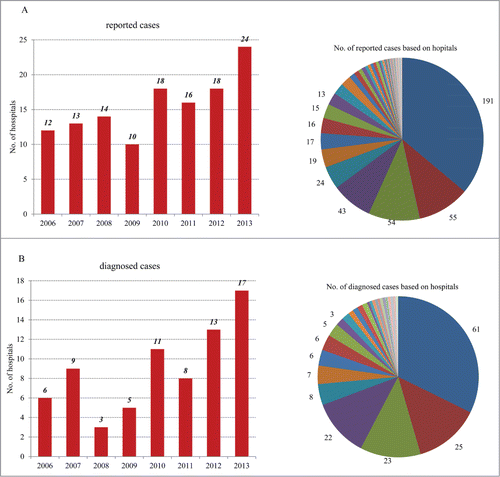
Hospital Transfer and Interval from Onset to the First Visit to Neurologists Between the Diagnosed CJD Patients from Beijing Region and Those Outside of Beijing
To see the potential differences between the patients from Beijing region and those outside of Beijing in their processes of CJD diagnosis, the intervals from disease onset to the first visit to neurologists, the intervals from disease onset to the final CJD diagnosis, and the numbers of hospital transfer till the final CJD diagnosis were collected. Only the visit or transfer of the hospitals with neurologists was counted, whereas the visits to the small clinics in the community were not included. Regarding the numbers of hospital transfer, all patients were divided into 4 groups, including no transfer (0 time), 1 time, 2 times and >3 times. 67.35% CJD cases from Beijing region were diagnosed without further hospital transfer and 24.49% patients had only 1 time of hospital transfer, which accounted for 90.82% of all CJD cases (). Contrarily, 50.74% and 27% CJD cases outside of Beijing had no and 1 time of hospital transfer before diagnosis, respectively, which covered 77.74% of all CJD patients outside of Beijing (). Further retrospective analysis revealed that all first visit hospitals of the CJD patients without history of hospital transfer in the group of outside of Beijing were Beijing's hospitals.
Figure 5. The numbers of hospital transfer (A), the interval from disease onset to the first visit to neurologists (B), and the interval from disease onset to the final diagnosis (C) between the diagnosed CJD patients from Beijing and outside of Beijing. The percentages of the CJD cases in each subgroup are indicated.
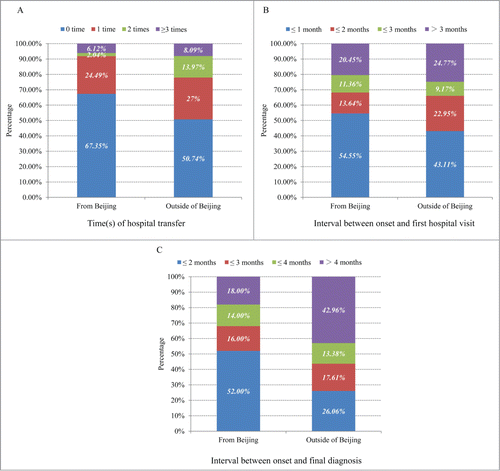
For the intervals from onset to the first visit to neurologists, all CJD patients were divided as ≤1 month, ≤2 months, ≤3 months and >3 months. For the patients visited their neurologists within 1 month after onset of symptoms, there was relatively larger portion of the CJD patients (54.55%) in the group of patients from Beijing than those outside of Beijing (43.11%) (). Moreover, the interval from onset to final diagnosis among the CJD patients were calculated as ≤2 months, ≤3 months, ≤4 months and >4 months. Obviously, more CJD patients from Beijing region finished their CJD diagnostic processes within 2 month (52.00%) after onset, while only 26.06% CJD cases outside of Beijing got their diagnoses within 2 month after onset (). In addition, the portion of the patients receiving CJD diagnosis longer than 4 months after onset in the group of outside of Beijing (42.96%) was significantly larger than those of Beijing region (18.00%).
Discussion
The national CJD surveillance program has been conducted since 2006. Although the program covers only 12 provincial administrative regions officially, there are still many suspected CJD cases reported from other provinces each year.Citation12,14,15 As one of initiated components for China CJD surveillance program, Beijing CJD surveillance network functions actively. In this study, the special features of Beijing CJD surveillance network have been analyzed based on the data of the national CJD surveillance from 2006 to 2013. As the unit having largest numbers both of suspected and diagnosed CJD cases in the national surveillance system in the past 8 years, Beijing CJD surveillance system supplies relevant medical service not only for the patients from Beijing regions, but also for those outside of Beijing, especially the neighbor provinces in Northern China. The reporting and diagnosed CJD cases come from decades of hospitals within Beijing region. We have also found that compared with the CJD patients outside of Beijing, the patients from Beijing have relatively short interval from the onset to the final CJD diagnosis and less numbers of hospital transfer.
As a group of rare disease, CJD and other subtypes of human prion diseases are relatively poorly recognized among the physician, even the neurologists.Citation16 Only a few cases have been described in some Chinese literatures before 2000. Based on that situation, a collaborative network for CJD was set up under the leadership of China CDC in 2002, which initially consists of the neurologists in several large hospitals in 4 central cities, aiming to diffuse CJD knowledge and find out suspected CJD cases.Citation15 Numerous CJD special workshops and training courses, either clinical or laboratory, have been conducted since then, especially in Beijing region, which contribute directly to an increasing numbers of the reporting and diagnosed CJD cases during past 8 y.
As the capital city of China, Beijing possesses unapproachable medical resources in the mainland of China. According to the China Health Statistical Yearbook 2013 (http://www.nhfpc.gov.cn/htmlfiles/zwgkzt/ptjnj/year2013/index2013.html), the numbers of medical staffs per thousand residences in Beijing in 2011 was 9.48 that is much higher than the average number of China (4.94), while the health expenditure per capita in Beijing was 4841.29 RMB that is also much higher than the average one in China (1806.95RMB). At the same time, the medical resources of the neighbor provinces were relatively weak, with less numbers of medical staffs per thousand residences and the lower health expenditure per capita, such as Hebei (4.32; 1461.53 RMB), Shanxi (5.53; 1555.72 RMB), Inner Mongolia (5.62; 2217.84 RMB), Henan (4.56; 1341.50 RMB) and Shandong (5.47; 1710.70 RMB). Additionally, there are decades of large hospitals (Grade 3) with the department of neurology in Beijing. Such abundant medical resources in Beijing supply the medical services not only to Beijing residents but also to the patients coming from various regions of China, especially from Northern and Northeastern China. It also contributes to Beijing CJD surveillance network for having predominantly more numbers of reporting and diagnosed CJD cases each year.
In 2013, there are 80 Grade 3 hospitals registered in Beijing (http://www.phic.org.cn/tonjixinxi/weishengtongjigongbao/201404/t20140415_73952.htm), among them 52 hospitals have the department of neurology. In the past 8 years, 45 hospitals have reported suspected CJD cases and 27 have had diagnosed CJD cases. Meanwhile, the numbers of the hospitals reporting CJD increase by years. Those data highlight a wide recognition of CJD and other prion diseases among the neurologists in Beijing. On the other hand, we have also noticed that large portions of reporting cases and diagnosed cases come from the hospitals with traditional advantage of neurology, such as Beijing Xuanwu Hospital, Peking Union Medical College Hospital, Beijing Tiantan Hospital, Peking University First Hospital, Beijing Youanmen Hospital and Beijing Friendship Hospital. Those six hospitals also receive more numbers of the patients from other provinces.
Besides of the direct contribution to CJD surveillance, the best medical resource and the best knowledge of CJD among the medical staff in Beijing let the patients from Beijing have remarkably shorter interval from the disease onset to the final diagnosis and less numbers of hospital transfer. Although CJD and other prion diseases are incurable diseases and early and quick diagnoses for CJD patients have little influence on their prognoses,Citation17 shorter interval from the disease onset to the final diagnosis and less numbers of hospital transfer definitely benefit to the patients for avoiding of too much clinical examinations and too much expenses in economics, meanwhile, also benefit to the family members for saving their mental and physical consumptions for searching the “correct answers,” in turn, having more times for nursing the patients.
From the data of this study here, we also notice that although Beijing CJD surveillance network works actively, the CJD morbidities based on the diagnosed CJD cases from Beijing region are markedly lower than we expect in most of the past 8 y. Even in the year of 2013 with highest numbers of diagnosed CJD cases, the calculated CJD morbidity in Beijing is 0.91 case/million/year (12 CJD cases/12.59 million). In other words, there are still CJD cases that are undiagnosed or misdiagnosed in Beijing. The CJD incidences are even much more underestimated in the context of whole mainland of China. In 2013, the diagnosed CJD and other prion diseases thought the national CJD surveillance system is 150. Based on this data, the morbidity of CJD in China is underestimated as 0.11/million/year. Such large amounts of undiagnosed and misdiagnosed CJD may undergo improper medical services, which might also leave potential and hidden problems in public health. Thus, continual and constant improvement for the capacity of CJD surveillance system is necessary.
Conclusion
The results of the present study revealed the characteristics and special role of Beijing CJD surveillance network in the national CJD surveillance system in China. During 2006 to 2013, totally 532 reporting cases and 192 diagnosed CJD cases were obtained in Beijing surveillance system and 75% of suspected and diagnosed CJD cases came from other provinces. 46 different hospitals in Beijing region have reported suspected CJD cases to the CJD surveillance system during this period. The diagnosed CJD patients from Beijing region had less numbers of hospital transfer and shorter interval from the disease onset to the final diagnosis than those outside of Beijing. It shows that Beijing CJD surveillance network functions more actively, which supplies the special medical services not only for Beijing residents but also for the patients from whole China.
Human Participant Protection statement
Usage of the stored human clinical data in China CJD Surveillance System has been approved by the Research Ethics Committee of National Institute for Viral Disease Control and Prevention, China CDC.
Disclosure of Potential Conflicts of Interest
No potential conflicts of interest were disclosed.
AUTHORS' CONTRIBUTION
Qi Shi contributed to designing and writing the paper. Xiu-Chun Zhang contributed to collecting and analyzing the data. Wei Zhou, Kang Xiao and Cao Chen contributed to analyzing the clinical data. Hai-Yan Zhang, Jing-Yi Sun, Li-Na Chen and Xiao-Mei Zhang contributed to analyzing the epidemiological data. Jun Han contributed to doing the follow-up data. Xiao-Ping Dong is the corresponding author and contributed to designing and writing the paper.
FUNDING
This work was supported by Chinese National Natural Science Foundation Grants (81301429), China Mega-Project for Infectious Disease (2011ZX10004-101, 2012ZX10004215) and SKLID Development Grant (2012SKLID102).
REFERENCES
- Liberski PP. Historical overview of prion diseases: a view from afar. Folia Neuropathol 2012; 50:1-12; PMID:22505359
- Prusiner SB. Prions. Proc Natl Acad Sci U S A 1998; 95:13363-83; PMID:9811807; http://dx.doi.org/10.1073/pnas.95.23.13363
- Fraser PE. Prions and prion-like proteins. J Biol Chem 2014; 289:19839-40; PMID:24860092; http://dx.doi.org/10.1074/jbc.R114.583492
- Appleby BS, Rincon-Beardsley TD, Appleby KK, Crain BJ, Wallin MT. Initial diagnoses of patients ultimately diagnosed with prion disease. J Alzheimers Dis 2014; 42:833-9; PMID:24934543
- Wieser HG, Schindler K, Zumsteg D. EEG in Creutzfeldt-Jakob disease. Clin Neurophysiol 2006; 117:935-51; PMID:16442343; http://dx.doi.org/10.1016/j.clinph.2005.12.007
- Shiga Y, Miyazawa K, Sato S, Fukushima R, Shibuya S, Sato Y, Konno H, Doh-ura K, Mugikura S, Tamura H, et al. Diffusion-weighted MRI abnormalities as an early diagnostic marker for Creutzfeldt-Jakob disease. Neurology 2004; 63:443-9; PMID:15304574; http://dx.doi.org/10.1212/01.WNL.0000134555.59460.5D
- Chohan G, Pennington C, Mackenzie JM, Andrews M, Everington D, Will RG, Knight RS, Green AJ. The role of cerebrospinal fluid 14-3-3 and other proteins in the diagnosis of sporadic Creutzfeldt-Jakob disease in the UK: a 10-year review. J Neurol Neurosurg Psychiatry 2010; 81:1243-8; PMID:20855493; http://dx.doi.org/10.1136/jnnp.2009.197962
- Chitravas N, Jung RS, Kofskey DM, Blevins JE, Gambetti P, Leigh RJ, Cohen ML. Treatable neurological disorders misdiagnosed as Creutzfeldt-Jakob disease. Ann Neurol 2011; 70:437-44; PMID:21674591; http://dx.doi.org/10.1002/ana.22454
- Satoh K, Tobiume M, Matsui Y, Mutsukura K, Nishida N, Shiga Y, Eguhchi K, Shirabe S, Sata T. Establishment of a standard 14-3-3 protein assay of cerebrospinal fluid as a diagnostic tool for Creutzfeldt-Jakob disease. Lab Invest 2010; 90:1637-44; PMID:20697380; http://dx.doi.org/10.1038/labinvest.2009.68
- Budka H. Neuropathology of prion diseases. Br Med Bull 2003; 66:121-30; PMID:14522854; http://dx.doi.org/10.1093/bmb/66.1.121
- Takada LT, Geschwind MD. Prion diseases. Semin Neurol 2013; 33:348-56; PMID:24234356; http://dx.doi.org/10.1055/s-0033-1359314
- Gao C, Shi Q, Tian C, Chen C, Han J, Zhou W, Zhang BY, Jiang HY, Zhang J, Dong XP. The epidemiological, clinical, and laboratory features of sporadic Creutzfeldt-Jakob disease patients in China: surveillance data from 2006 to 2010. PLoS One 2011; 6:e24231; PMID:21904617; http://dx.doi.org/10.1371/journal.pone.0024231
- Newey CR, Sarwal A, Wisco D, Alam S, Lederman RJ. Variability in diagnosing Creutzfeldt-Jakob disease using standard and proposed diagnostic criteria. J Neuroimaging 2013; 23:58-63; PMID:23163590; http://dx.doi.org/10.1111/j.1552-6569.2012.00763.x
- Chen C, Wang JC, Shi Q, Zhou W, Zhang XM, Zhang J, Tian C, Gao C, Dong XP. Analyses of the survival time and the influencing factors of chinese patients with prion diseases based on the surveillance data from 2008-2011. PLoS One 2013; 8:e62553; PMID:23671608; http://dx.doi.org/10.1371/journal.pone.0062553
- Shi Q, Gao C, Zhou W, Zhang BY, Chen JM, Tian C, Jiang HY, Han J, Xiang NJ, Wang XF, et al. Surveillance for Creutzfeldt-Jakob disease in China from 2006 to 2007. BMC Public Health 2008; 8:360; PMID:18928564; http://dx.doi.org/10.1186/1471-2458-8-360
- Panegyres PK, Armari E. Therapies for human prion diseases. Am J Neurodegener Dis 2013; 2:176-86; PMID:24093082
- Krasnianski A, Kaune J, Jung K, Kretzschmar HA, Zerr I. First symptom and initial diagnosis in sporadic CJD patients in Germany. J Neurol 2014; 261:1811-7; PMID:25022936; http://dx.doi.org/10.1007/s00415-014-7410-z

